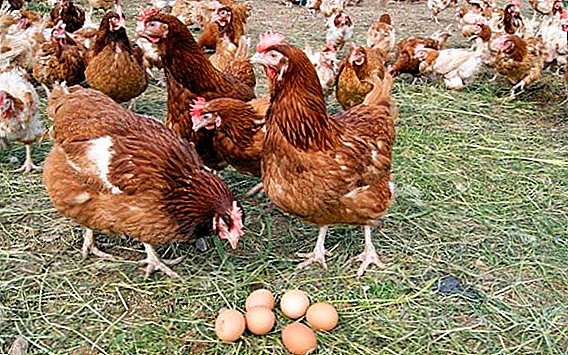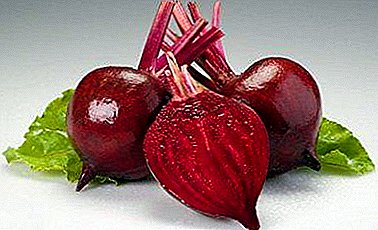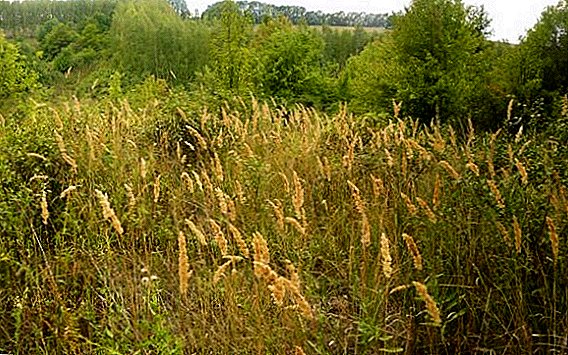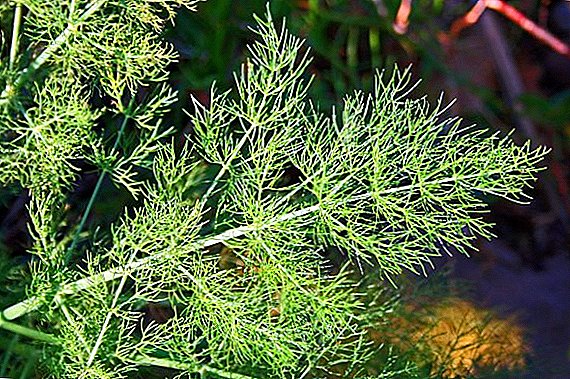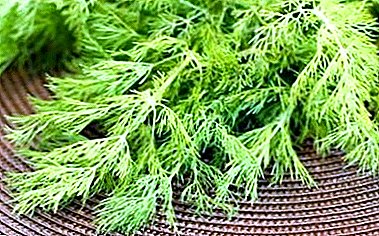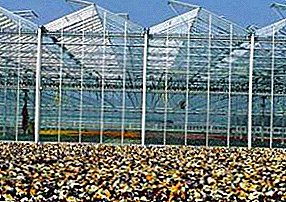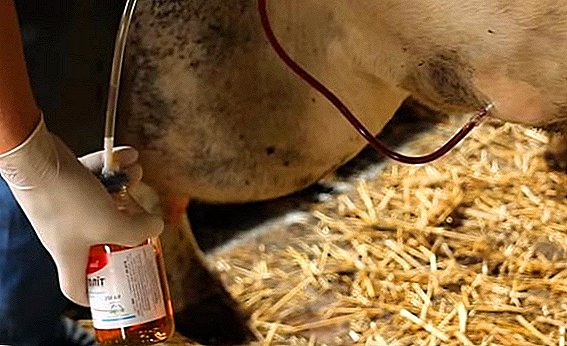 Keeping cows in an unnatural environment for them, that is, on livestock farms, etc., often causes many diseases in them, one of which is ketosis. In this article, we learn what it is, how to diagnose ketosis in cattle (cattle), how to treat it, and what preventive measures should be followed to avoid the appearance of this disease.
Keeping cows in an unnatural environment for them, that is, on livestock farms, etc., often causes many diseases in them, one of which is ketosis. In this article, we learn what it is, how to diagnose ketosis in cattle (cattle), how to treat it, and what preventive measures should be followed to avoid the appearance of this disease.
What kind of disease is it dangerous for?
Ketosis, or acetonemia - A disease that is characterized by the accumulation of ketones in cows, which in animals cause metabolic disturbances in carbohydrates, fats and proteins. Ketones appear due to excessive amounts of food products with incomplete decomposition of proteins and carbohydrates in cattle predusting, which in turn causes a slowdown in the absorption of ammonia and forms, on the basis of this element, oil and acetic acids, which are converted to acetone and beta-hydroxybutyric acid; substances and pollute the body.  Acetonemia of cows brings a lot of losses, because as a result of this disease milk production decreases by at least 50%, the livestock use period is reduced to 3 years, the reproductive function is disturbed, and the animal's weight decreases.
Acetonemia of cows brings a lot of losses, because as a result of this disease milk production decreases by at least 50%, the livestock use period is reduced to 3 years, the reproductive function is disturbed, and the animal's weight decreases.
Breeding cows is associated with the risk of developing diseases: leukemia, mastitis, udder edema, pasteurellosis, foot and mouth disease, and hoof diseases.
Also, ketones enter the fetus through the placenta and can cause an abortion or a dead calf can be born, if the calf was born alive, it will be very weak and highly susceptible to various diseases.
The reasons
Today, it can be said with confidence that ketosis is in no way connected with any particular season of the year, and may appear any time. The only thing that can be noted - in the period of grazing on pastures, the incidence rate decreases several times. In most cases, individuals from 4 years to 7 years are prone to acetonemia in the last months of the offspring and within a month and a half after calving. 
Important! If the animal is constantly in the stall, the probability of occurrence of the disease increases significantly.This disease is caused not by one cause, but by the whole complex. One of the main factors causing ketosis in cows that give a lot of milk is feeding with a large number of feeds that contain a lot of proteins, and when at the same time the animal loses carbohydrates.
The disease may occur due to the consumption of silage, which contains butyric acid in large quantities. The development is promoted by the feeding of sour pulp from beets, spoiled products, and also fat concentrated products (for example, cake).
An equally important factor can be called carbohydrate or protein deficiency at high milk yields. With a lack of carbohydrates, the body begins to absorb glycogen from the liver, and for this reason hypoglycemia develops, which contributes to the appearance of ketosis.
Milking machines greatly simplify the process of milking and increase the number of milk production. Learn about the best lobes for cows and goats.
 Disorders in the endocrine system, which are accompanied by a small release of glucocorticosteroids, adrenocorticotropic and thyroid hormones. Also, the cause of acetonemia can be diseases of the stomach and genitals.
Disorders in the endocrine system, which are accompanied by a small release of glucocorticosteroids, adrenocorticotropic and thyroid hormones. Also, the cause of acetonemia can be diseases of the stomach and genitals.
Did you know? Ketosis can also affect people, but it is not transmitted from cattle.
Symptoms
The first thing to pay attention to is the quality of milk. After milk production, the product has a bitter taste, and there are hints of acetone in its smell, while the typical foam is often not formed on the surface of the milk itself. The animal becomes not so mobile, there is a decrease in weight, and the scalp loses its luster.  There is a loss of appetite, and with it the milk yield drops sharply, up to their complete cessation, and the cow begins to smell like acetone.
There is a loss of appetite, and with it the milk yield drops sharply, up to their complete cessation, and the cow begins to smell like acetone.
There are obvious changes in physiological features: saliva is liberally released, a shiver passes through the body, non-inherent gnashing of teeth appears, the temperature drops dramatically, cattle spend more time lying down. Hypersensitivity to external stimuli appears, cows get very scared and constantly mooing.
Diagnostics
If you notice similar external signs of the disease, for a more accurate diagnosis, refer to the scientific methods. To do this, you need to test the concentration of protein and fat in the resulting raw materials - a difference of one and a half percent indicates the likely content of ketone elements.  Along with this, in laboratory conditions, analysis of dairy products and urine of livestock is carried out. Most often resort to sample Lestrade, the essence of which lies in the use of dry reagent. It can be prepared from ammonium sulfate, sodium nitroprusside and anhydrous sodium carbonate in a ratio of 20: 1: 20 g. 10 ml of milk or urine is injected into this solution. If the presence of pathogenic bodies is detected, then the entire reagent becomes purple.
Along with this, in laboratory conditions, analysis of dairy products and urine of livestock is carried out. Most often resort to sample Lestrade, the essence of which lies in the use of dry reagent. It can be prepared from ammonium sulfate, sodium nitroprusside and anhydrous sodium carbonate in a ratio of 20: 1: 20 g. 10 ml of milk or urine is injected into this solution. If the presence of pathogenic bodies is detected, then the entire reagent becomes purple.
Treatment specificity
If ketosis is accurately identified in cows, then treatment at home should be carried out without delay.
Be sure to pay attention to the diet of livestock: If you find a food with mold, then immediately get rid of it. It is necessary to provide the animal with fresh feed, which should include up to 10 kg of good hay, dried grass, and root crops, including potatoes.
Learn how to treat ketosis in a goat.
 Drug treatment is prescribed to normalize all the basic functions of a weakened organism. Injections with a glucose content of at least twenty percent with an interval of 12 hours are administered from three to four days.
Drug treatment is prescribed to normalize all the basic functions of a weakened organism. Injections with a glucose content of at least twenty percent with an interval of 12 hours are administered from three to four days.
Important! When ketosis of sick animals otpaivat sweetened water.In order to reduce the elevated level of acetone in the blood, sodium bicarbonate is administered intravenously or this solution for infusion is mixed with drinking water.
As another treatment option, it is recommended to inject into the abdominal cavity a mixture according to the composition of Sharabrin and Shaykhamanov, adhering to a dose of two liters.  To put in order the genital and endocrine systems, it will not be superfluous to use hormonal medications, which include oxytocin-containing medications.
To put in order the genital and endocrine systems, it will not be superfluous to use hormonal medications, which include oxytocin-containing medications.
Preventive measures
The best prevention of ketosis in cows is how often you can release an animal to fresh air. It is better to exclude the same type and containing an increased level of acid feed. Freshly cut grass, beets, turnips and other root vegetables should be added to food for livestock, as they provide constant cleaning of the gastrointestinal tact, normalize the level of acid-base balance.
Cows during lactation in the feed add cereals, molasses, as well as a special fat intended for feeding animals. However, do not overfeed livestock, as this can lead to an increase in the protein content in the rumen, and this is fraught with a violation of the gastrointestinal tract.  Also, do not forget about the purity of the feeders, drinking bowls and the boxes for animal sludge. Observing the basic rules of a full balanced feeding and quality care, you can reduce the risk of not only ketosis, but also many other diseases of cattle.
Also, do not forget about the purity of the feeders, drinking bowls and the boxes for animal sludge. Observing the basic rules of a full balanced feeding and quality care, you can reduce the risk of not only ketosis, but also many other diseases of cattle.
Did you know? The appearance of the disease is also associated with the "bad mood" of the animal, if the cow is often under stress, the likelihood of ketosis increases several times.Ketosis is a disease that has a very negative effect on cattle and causes great losses to farmers. Although ketosis is treatable, it is still better to prevent it by adhering to the rules of prevention.


